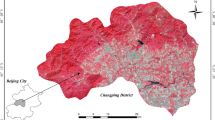Abstract
The main objective of this study is to generate a knowledge base which is composed of user-defined variables and included raster imagery, vector coverage, spatial models, external programs, and simple scalars and to develop an expert classification using Landsat 7 (ETM+) imagery for land cover classification in a part of Trabzon city. Expert systems allow for the integration of remote-sensed data with other sources of geo-referenced information such as land use data, spatial texture, and digital elevation model to obtain greater classification accuracy. Logical decision rules are used with the various datasets to assign class values for each pixel. Expert system is very suitable for the work of image interpretation as a powerful means of information integration. Landsat ETM data acquired in the year 2000 were initially classified into seven classes for land cover using a maximum likelihood decision rule. An expert system was constructed to perform post-classification sorting of the initial land cover classification using additional spatial datasets such as land use data. The overall accuracy of expert classification was 95.80%. Individual class accuracy ranged from 75% to 100% for each class.
Similar content being viewed by others
References
Bastin, L. (1997). Comparison of fuzzy c-means classification, linear mixture modeling and MLC probabilities as tools for unmixing coarse pixels. International Journal of Remote Sensing, 18, 3629–3648. doi:10.1080/014311697216847.
Berberoglu, S., Lloyd, C. D., Atkinson, P. M., & Curran, P. J. (2000). The integration of spectral and textural information using neural networks for land cover mapping in the Mediterranean. Computers & Geosciences, 26, 385–396. doi:10.1016/S0098-3004(99)00119-3.
Chien, F. J., & Chou, T. Y. (2000). The study of knowledge based database assist for urban land use classification. GIS Research Center, Department of Land Management, Feng Chia University.
Cole, C., Wentz, E., & Christensen, P. (2005). Expert system approach for classifying land cover in New Delhi India using ASTER imagery, 3rd International Symposium on Remote Sensing and Data Fusion Over Urban Areas (URBAN 2005), Tempe, AZ, USA, 14–16 March 2005.
Congalton, R. G., & Green, K. (1999). Assessing the accuracy of remotely sensed data: Principles and practices. New York: Lewis.
ERDAS (1999). ERDAS field guide (5th ed.). Atlanta: ERDAS.
Fisher, P. F., & Pathirana, S. (1990). The evaluation of fuzzy membership of land cover classes in the suburban zone. Remote Sensing of Environment, 34, 121–132. doi:10.1016/0034-4257(90)90103-S.
Foody, G. M. (2000). Estimation of sub-pixel land cover composition in the presence of untrained classes. Computers & Geosciences, 26, 469–478. doi:10.1016/S0098-3004(99)00125-9.
Gong, P., & Howarth, P. J. (1990). The use of structural information for improving land-cover classification accuracies at the rural–urban fringe. Photogrammetric Engineering and Remote Sensing, 56(1), 67–73.
Huete, A. R. (1988). A soil-adjusted vegetation index SAVI. Remote Sensing of Environment, 25, 295–309. doi:10.1016/0034-4257(88)90106-X.
Iron, J. R., & Petersen, G. W. (1981). Texture transforms of remote sensing data. Remote Sensing of Environment, 11, 359–370. doi:10.1016/0034-4257(81)90033-X.
Jensen, J. R. (1996). Introductory image processing: A remote sensing perspective (2nd ed.). Upper Saddle River: Prentice-Hall.
Kumar, A. S., Basu, S. K., & Majumdar, K. L. (1997). Robust classification of multispectral data using multiple neural networks and fuzzy integral. IEEE Transactions on Geoscience and Remote Sensing, 35, 787–790. doi:10.1109/36.582004.
Lyon, J. G., Yuan, D., Lunetta, R. S., & Elvidge, C. D. (1998). A change detection experiment using vegetation indices. Photogrammetric Engineering and Remote Sensing, 642, 143–150.
Mattikalli, N. M. (1997). Soil color modeling for the visible and near-infrared bands of Landsat sensors using laboratory spectral measurements. Remote Sensing of Environment, 59, 14–28. doi:10.1016/S0034-4257(96)00075-2.
Paola, J. D., & Schowengerdt, R. A. (1995). A detailed comparison of back propagation neural networks and maximum likelihood classifiers for urban land use classification. IEEE Transactions on Geoscience and Remote Sensing, 33, 981–996. doi:10.1109/36.406684.
Pax-Lenney, M., & Woodcock, C. E. (1997). The effect of spatial resolution on the ability to monitor the status of agricultural lands. Remote Sensing of Environment, 61, 210–220. doi:10.1016/S0034-4257(97)00003-5.
Ridd, M. K. (1995). Exploring a V–I–S (vegetation–impervious surface–soil) model for urban ecosystem analysis through remote sensing: Comparative anatomy for cities. International Journal of Remote Sensing, 16, 2165–2185. doi:10.1080/01431169508954549.
Stefanov, W. L., & Netzband, M. (2005). Assessment of ASTER land cover and MODIS NDVI data at multiple scales for ecological characterization of an arid urban center. Remote Sensing of Environment, 99, 31–43. doi:10.1016/j.rse.2005.04.024.
Stefanov, W. L., Ramsey, M. S., & Christensen, P. R. (2001). Monitoring urban land cover change: An expert system approach to land cover classification of semiarid to arid urban centers. Remote Sensing of Environment, 77, 173–185. doi:10.1016/S0034-4257(01)00204-8.
Stuckens, J., Coppin, P. R., & Bauer, M. E. (2000). Integrating contextual information with per-pixel classification for improved land cover classification. Remote Sensing of Environment, 71, 282–296. doi:10.1016/S0034-4257(99)00083-8.
Sultan, M., Arvidson, R. E., Sturchio, N. C., & Guinness, E. A. (1987). Lithologic mapping in arid regions with Landsat TM data: Meatiq dome. Geological Society of America Bulletin, 99, 748–762. doi:10.1130/0016-7606(1987)99<748:LMIARW>2.0.CO;2.
Vogelmann, J. E., Sohl, T., & Howard, S. M. (1998). Regional characterization of land cover using multiple sources of data. Photogrammetric Engineering and Remote Sensing, 64, 45–57.
Wilkie, D. S., & Finn, J. T. (1996). Remote sensing imagery for natural resources monitoring: A guide for first-time users. New York: Columbia University Press.
Author information
Authors and Affiliations
Corresponding author
Rights and permissions
About this article
Cite this article
Kahya, O., Bayram, B. & Reis, S. Land cover classification with an expert system approach using Landsat ETM imagery: a case study of Trabzon. Environ Monit Assess 160, 431–438 (2010). https://doi.org/10.1007/s10661-008-0707-6
Received:
Accepted:
Published:
Issue Date:
DOI: https://doi.org/10.1007/s10661-008-0707-6




